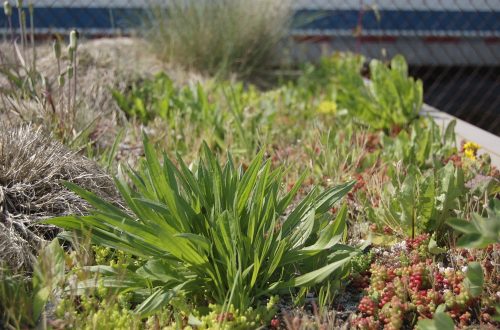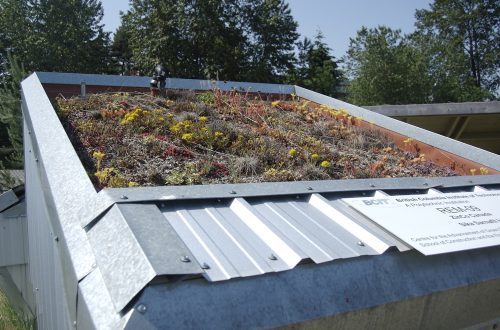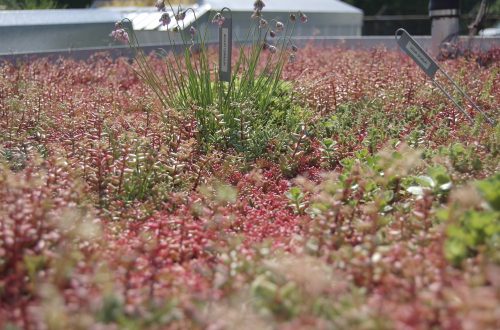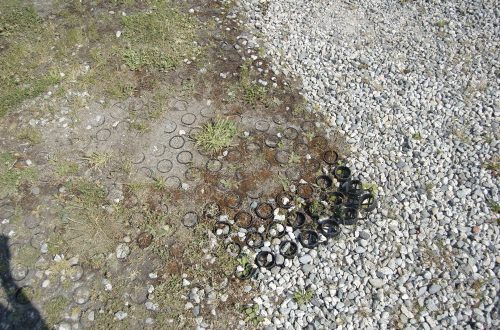Our Brooklyn Green Show House has doubled up joists in the roof in anticipation of a heavy green roof.
I’m talking with my friends Atom and Lori, who are publishing a book on DYI green roofs in Brooklyn. We are seeing if they can install the roof on the show house as part of their class on installing a green roof on a Brooklyn Brownstone.
That’s the kind of synergy we like: green building, community participation and education. the class is happening end of June if anyone wants to take it.
Brooklyn Green Roof Problem
The only problem is that I see the green roof on the show house as being deeper than what they like. I had envisioned a 5-6 inch growing medium with a lush landscape of local plants. A wild revival of Brooklyn foliage. I saw this as going against the norm of the boring flat bed of sedum with a shallow 2-3 inch layer of growing medium.
But they think a 2-3 inch layer is more sustainable. What I love about this discussion is that we are exploring the most sustainable ways to build a green roof. That is like discussing the most healthy yoga poses. It’s basically advanced green building mentality: we’re green but how can we be even greener. That’s a beautiful thing.
So back to how thick the show house roof should be. I had planned for a thick growing medium. But here is an email response from Atom:
Here are some photos for you to check out. I want explain why doing a roof like ours is actually going against the norm, because most greenroof designers and installers want you to put in more soil…for two main reasons.
1.they make more money on the installation
2.they make more money in follow up weeding and maintaining.
You can have a very diverse roof with 2-3 inches of soil. Your roof already will have several microclimates due to parapets, awning, stairwell entrance. It is such a small roof and all of these will introduce shade and wind protection and create a very interesting little biosphere in the sky! All the newest research is also coming out that 2 inches not only supports enough diversity, but limits the amount of weeding is needed. Weeds just stay away!!!(which is what you want!!)
Residential Category of Green Roofs
Planting a variety of native sedums, and native strawberries, which is what the Lower East Side Ecology Center is doing on there roof (the Executive Director is a biologist), will give you a very diverse plant selection and fit under within the drought resistant category for greenroofs, and support the nature we have in our urban area(birds, bees, butterflies, etc) Planting this way supports weed resistances and longevity of your roof, and therefore supports our natural habitat naturally, real sustainability. This is what I feel you are looking for…
As you can see in my images. Sedums come in a variety of sizes and flower at different times throughout the spring/summer….they also create a very diverse landscape.
VERY EXPERIMENTAL IDEAS FOR YOUR ROOF:
1. We suggest we create smallish mounds on the roof (with styrofoam) and build our roof on top of this created landscape. This will give you even more microclimates and visual appeal
2.create a living wall system using bed mattress steel wire frames. The wire frames can be installed on the walls of your stairwell entrance and support some vines. Similar to the new system http://greenscreen.com/. This will also give you some more garbage style sustainability.
I think we are on the same page. Creating sustainability that “all” of us can afford and achieve!!
Sample image s 1-5 are some images of sedums (a few weeds) and the diversity they provide.
The last image is of a system used to support walking on the plants, a plant paver one might say. I am trying to track down this system for you and for our book, I think this is what you wanted for the path right???
====
I have to say I’m starting to see their point….the discussion continues…
Here are the green roof examples Atom sent me.






